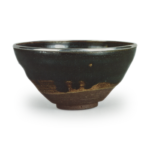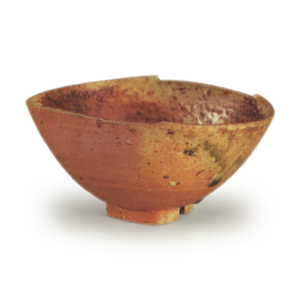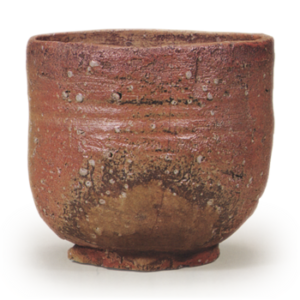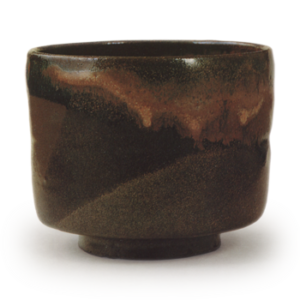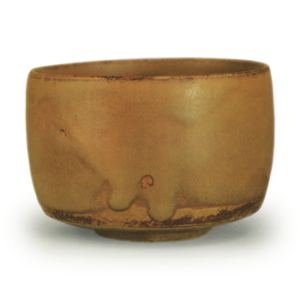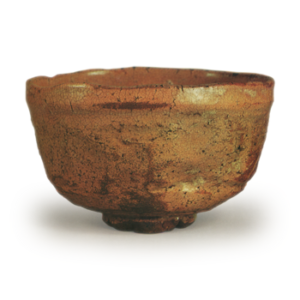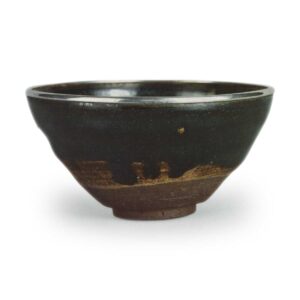
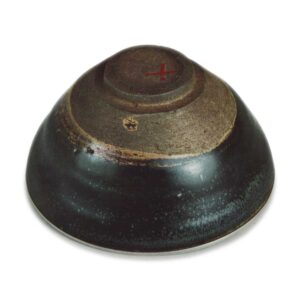
Name: Numata
Height: 6.7 – 6.9 cm
Diameter: 12.4 – 12.7 cm
Outer diameter of foot ring: 4.3 cm
Height of foot ring: 0.7 cm
This tea bowl was once owned by the tea master Matsudaira Fumai, and is mentioned in the “Unshu Meibutsu Ki” (A Record of Famous Tea Bowl from Unshu) as
Kotenmoku Numata Tenmokudai Rikyu-mon Nara ya Gen-shichi
and is listed in the “Famous Tea Bowl Collection” section. The date when it came into the possession of Lord Fumai is unknown. The text of the accompanying letter written by Sen no Rikyu is
This tea bowl is a Tenmoku tea bowl
I hope to have a chance to talk with you again
I am satisfied with the way you have handled the matter
I hope you will continue to take care of me
I pray for your peace of mind. With deepest respect
July 16th
To
Matsunobu-sama and all
The addressee, “Matsunobu-sama”, was Matsui Sadomori Yasuyuki, a retainer of the Hosokawa family and a close friend of Rikyu, who was commonly known as Shinsuke. The “Yosama” mentioned in the letter is, needless to say, Hosokawa Sansai.
When Rikyu was shown the tea bowl by Matsui Sadomori, he said, “It is a yellow tenmoku,” but it is thought that the style of the bowl is actually haikibitenmoku. The tea bowl is extremely similar to the one that came down in the Kishu Hikawa family, both in terms of the bowl and the glaze, and is different from the one that came down in the Owari Tokugawa family. The Ooshu family’s yellow tenmoku has a yellowish-brown glaze that is very much in keeping with the name ‘yellow tenmoku’, but I think it would be better to describe this ‘Numata’ as haikibori. And when you compare the yellow tenmoku from the Fujita family with the yellow tenmoku from the Ooshu Tokugawa family, you can see that they are also different in style, and when you compare the haikibori from the Ooshu Tokugawa family with the haikibori from the Kishu Tokugawa family are also completely different in terms of their production methods, and while the Bishu haikai are thought to have been made at the Ken kiln, the Kishu haikai are difficult to attribute to the Ken kiln.
From the above, we can infer that Tenmoku tea bowls, which have been called “haikui” or “kitenmoku” since ancient times, were not strictly classified, and that bowls with a haikui-like appearance, such as the “Numata”, were classified as “kitenmoku” if they had a strong yellow color, suggesting that they were classified according to the subjective impressions of the viewer. The glaze is applied in two layers, as in the Kishu ware, and the area around the foot of the glaze is yellow, while the upper part and the inside of the bowl have a glossy black glaze. On the other side, there are oil-drop-like silver flecks that appear quietly from the rim to the body of the bowl.
The foot ring, which shows a slightly rough grayish-gray clay surface, has been chamfered and the foot ring has been carved out to a curved shape. The way the foot ring has been carved out to a curved shape is a style that is not seen in the Tenmoku ware of the Ken kiln.
The yellow flecks on the rim are striking, and there is also a red lacquered “ten” inside the rim. The rim is silver.
On the lid of the paulownia wood box, the words “Numata Ki-Tenmoku” are written in Fumai’s hand, and on the box for the Tenmoku stand with the red lacquer floral pattern, the words “Numata Tenmoku” are written, and on the box for the large camellia-patterned white gold-lacquered pouch, the words “Shoda Ki-Tenmoku Pouch” are written, all in Fumai’s hand.
Before Fumai, the only mention of it in the “Unshu Meibutsu Ki” is “Naraya Genshichi”, so if the letter from Rikyu was attached from the beginning, it may have been in the possession of Matsui Sadomori during the Rikyu period.

